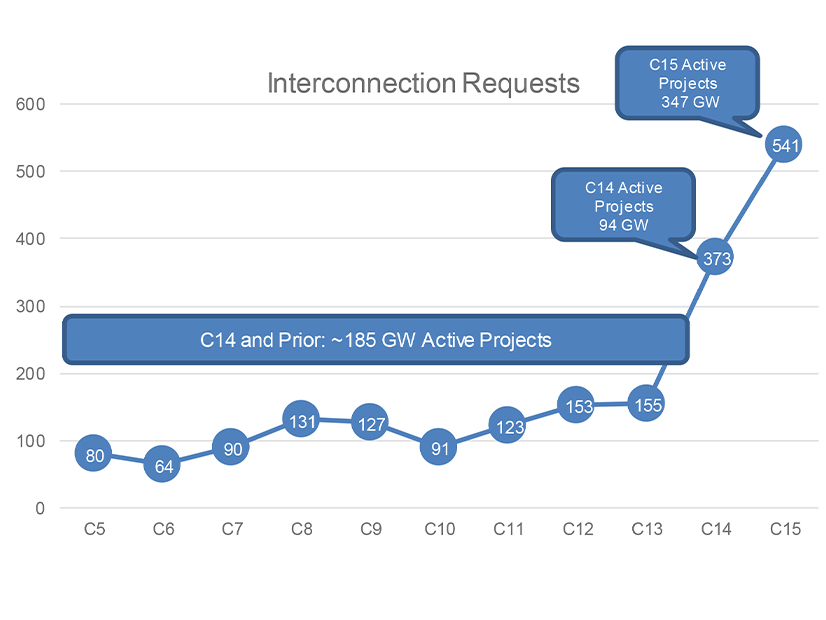
CAISO’s Board of Governors on June 12 unanimously approved the ISO’s Interconnection Process Enhancements proposal, the product of more than a year of stakeholder engagement and rigorous troubleshooting.
Intended to complement — but not replace — CAISO’s FERC Order 2023 compliance filing, the final proposal is designed to streamline the interconnection process in response to the “unprecedented volume” of requests the ISO received last year by reducing the number of projects it will have to study. (See Stakeholders Seek Clarity on CAISO Interconnection Process Plan.)
During the June 12 board meeting, Danielle Osborn Mills, CAISO principal of infrastructure policy development, presented slides showing that Cluster 15 in April 2023 vastly exceeded expectations and the interconnection queue now contains roughly three times the capacity needed to achieve California’s 2045 requirements.
“I cannot overstate the importance of this initiative and the challenges our team and stakeholders faced in developing these transformative changes to our interconnection process,” Neil Millar, CAISO vice president of transmission planning and infrastructure development, said at the meeting.
“The fundamental transformation we are seeking to implement is to shift more meaningful project development and procurement engagement to earlier stages in the interconnection study process,” Millar said. “While these changes will be disruptive and uncomfortable, they are necessary so that the ISO can deliver meaningful study results more quickly and phase out the habit of using the ISO interconnection process to simply screen potential sites.”
Responding to stakeholder feedback, CAISO staff made one key change to the final proposal not included in prior drafts: a requirement for load-serving entities to opt in to the point allocation process and publicly post both contact information for the department or individual responsible for the process and selection criteria for allocating capacity.
The change is intended to “increase the transparency and rigor of the load-serving entity allocation process,” Mills said. The prioritization of LSE interest in the scoring and point allocation process has been a significant area of concern for stakeholders.
Scoring Criteria Concerns
While the proposal received broad support during the board meeting, many stakeholders expressed concern about moving forward with the final proposal.
“One of the biggest concerns is the lack of allocation to the non-load-serving entities,” said Melissa Alfano, senior director of energy markets and counsel at the Solar Energy Industries Association. “There is the ability for the LSEs to withhold some things and strategically push forward less efficient projects.”
Other stakeholders echoed Alfano’s concerns.
“The scoring criteria are rooted in significant potential for a lack of transparency, unjust discrimination against non-LSE developers with viable projects and infringement upon principles of open access,” said Ryan Millard, senior director of West region regulatory and political affairs at NextEra Energy Resources. Other stakeholders “also highlighted instances of LSEs seeking concessions from developers in exchange for early points allocation which demonstrates a clear risk of exploitation.”
He gave an example of a recent instance in which an LSE indicated to NextEra that it issues a request for proposals that includes Cluster 15 projects and would require developers to grant the LSE a right of first offer and submit a $5/kW deposit to secure LSE point allocation.
“To put that into context for you, if you were to apply this to a 300-MW storage project, that’s a $1.5 million deposit that we would need to post 10 years before expected [commercial operation date] just to enter the queue. That’s untenable, even for some of the largest Western developers,” Millard said. “While we appreciate CAISO’s desire not to propose a prescriptive [request for information] process for LSEs, the absence of minimum standards introduces too much potential inequity.”
Mills responded that the setting of standards falls under the jurisdiction of the California Public Utilities Commission and individual local regulatory authorities, not the ISO. Additionally, she emphasized that the ISO would continue to monitor the LSE allocation process after implementation and that the CPUC will exercise oversight over the procurement process, “scrutinizing utility-owned contracts against other contracts” to make sure they were selected fairly and transparently.
“We did not want to do anything that was going to open the floodgates to only utility-owned generation, but at the same time, [we] didn’t want to do anything that was going to discourage or prevent it either,” Mills said.
CAISO CEO Elliot Mainzer also weighed in.
“We all know that any system of rules that you set up, including the existing system, can be subject to untoward behavior,” he said. “We know that there are risks here, and we have taken steps both within our tariff and in direct consultation with the leadership of the state and other local regulatory authorities to make sure that their processes are monitored carefully to make sure that we do not see untoward behavior or manipulation of the rules.”
The ISO said it intends to file the changes with FERC in July and hopes to begin study of Cluster 15 projects in October.


